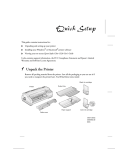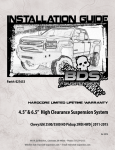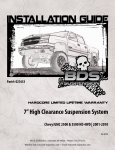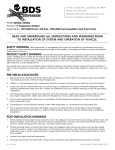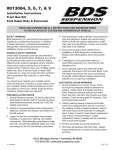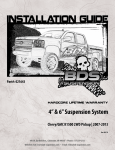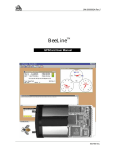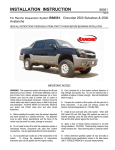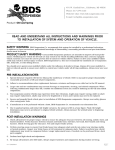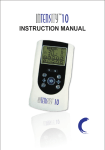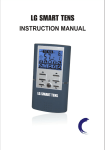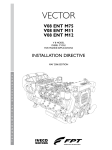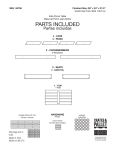Download BDS Suspension Installation Instructions
Transcript
491 W. Garfield Ave., Coldwater, MI 49036 Phone: 517-279-2135 Web/live chat: www.bds-suspension.com E-mail: [email protected] Part#: 021623, 021624 Product: 6" Suspension System Application: 2001-2006 Chevy/GMC 2500 HD 2WD Read and understand all instructions and warnings prior to installation of system and operation of vehicle. SAFETY WARNING BDS Suspension Co. recommends this system be installed by a professional technician. In addition to these instructions, professional knowledge of disassembly/ reassembly procedures and post installation checks must be known. PRODUCT SAFETY WARNING Certain BDS Suspension products are intended to improve off-road performance. Modifying your vehicle for off-road use may result in the vehicle handling differently than a factory equipped vehicle. Extreme care must be used to prevent loss of control or vehicle rollover. Failure to drive your modified vehicle safely may result in serious injury or death. BDS Suspension Co. does not recommend the combined use of suspension lifts, body lifts, or other lifting devices. You should never operate your modified vehicle under the influence of alcohol or drugs. Always drive your modified vehicle at reduced speeds to ensure your ability to control your vehicle under all driving conditions. Always wear your seat belt. Pre-Installation Notes 1. Special literature required: OE Service Manual for model/year of vehicle. Refer to manual for proper disassembly/ reassembly procedures of OE and related components. 2. Adhere to recommendations when replacement fasteners, retainers and keepers are called out in the OE manual. 3. Larger rim and tire combinations may increase leverage on suspension, steering, and related components. When selecting combinations larger than OE, consider the additional stress you could be inducing on the OE and related components. 4. Post suspension system vehicles may experience drive line vibrations. Angles may require tuning, slider on shaft may require replacement, shafts may need to be lengthened or trued, and U-joints may need to be replaced. 5. Secure and properly block vehicle prior to installation of BDS Suspension components. Always wear safety glasses when using power tools. 6. If installation is to be performed without a hoist, BDS Suspension Co. recommends rear alterations first. 7. Due to payload options and initial ride height variances, the amount of lift is a base figure. Final ride height dimensions may vary in accordance to original vehicle attitude. Always measure the attitude prior to beginning installation. POST-INSTALLATION WARNINGS 1. Check all fasteners for proper torque. Check to ensure for adequate clearance between all rotating, mobile, fixed, and heated members. Verify clearance between exhaust and brake lines, fuel lines, fuel tank, floor boards and wiring harness. Check steering gear for clearance. Test and inspect brake system. 2. Perform steering sweep to ensure front brake hoses have adequate slack and do not contact any rotating, mobile or heated members. Inspect rear brake hoses at full extension for adequate slack. Failure to perform hose check/ replacement may result in component failure. Longer replacement hoses, if needed can be purchased from a local parts supplier. 3. Perform head light check and adjustment. 4. Re-torque all fasteners after 500 miles. Always inspect fasteners and components during routine servicing. rev. 4/29/2013 021623, 021624 Page 1 PARTS LIST Part # Bolt Pack 544 Qty Description 01178 1 Steering Knuckle- DRV 01179 1 Steering Knuckle- PASS 542 1 Bolt Pack 544 1 Bolt Pack 545 1 Bolt Pack 01198 1 Front Crossmember 01199 1 Rear Crossmember M02096-RB 2 Bump Stop 02100 2 Crossmember Brace 01188 2 Compression Strut 01189 2 Compression Strut Mount 01190 2 Strut Mount Nut Tab 01191 2 Torsion Bar Drop Bracket 01196 2 Rear Bump Stop Spacers 01661 1 Brake Line Bracket 2081BK 8Bushing 32-1 4 5/8” x 0.083” x 2.365” Sleeve 01325 4U-Bracket 911104 2 Sway Bar Link SB58RB4 Bushing 45313 4Sleeve BSC0754Bushing 44-1 2Sleeve SBLA 1 Brake Line Bracket 2Loctite® 2 2 4 8 2 2 2 6 6 6 6 5/8”-11 x 6” bolt 5/8”-11 x 5” bolt 5/8”-11 prevailing torque nut 5/8” SAE flat washer 3/8”-16 standard hex nut 3/8” SAE flat washer 3/8” lock washer 1/4”-20 x 3/4” bolt 1/4” SAE flat washer 1/4” lock washer Wire Clamp Bolt Pack 545 4 12 12 24 4 4 8 1 1 2 7/16”-14 x 3-1/2” bolt 7/16”-14 x 1-1/4” bolt 7/16”-14 prevailing torque nut 7/16” SAE flat washer 3/8”-16 x 1-1/2” bolt 3/8”-16 prevailing torque nut 3/8” SAE flat washer 5/16”-18 x 1” bolt 5/16”-18 prevailing torque nut 5/16” USS flat washer Bolt Pack 542 4 4 4 4 4 4 8 7/16”-14 x 1-1/4” bolt 7/16” SAE flat washer 7/16” USS flat washer 7/16”-14 prevailing torque nut 3/8”-16 x 2-1/2” bolt 3/8”-16 prevailing torque nut 3/8” SAE flat washer PRE-INSTALLATION MEASUREMENTS Measure from the center of the wheel up to the bottom edge of the wheel opening LF______ RF______ LR______ RR______ FRONT INSTALLATION 1. Park the vehicle on a clean, level surface and block the rear wheels for safety. 2. Safely raise the front of vehicle and support with jack stands for safety. 3. Remove the wheels. 4. Measure and record the length of the exposed thread on the torsion bar adjusting bolts for later reference. DRV__________ PASS__________ 5. Remove the torsion bar assembly. CAUTION: The torsion bar is under extreme pressure. Use the correct unloading tool to remove the pressure on the torsion bars before attempting to remove the assembly. A J36202 or equivalent torsion bar unloading tool must be used. Be sure to follow the OE manual and the torsion bar unloading tool literature as to how to unload the torsion bars. 6. Unload the torsion bars, but do not remove. Page 2 021623, 021624 7. Mark the unloaded torsion bars to indicate passenger’s and driver’s side. Mark both of the torsion bars to indicate the front verses the rear for later installation. Also mark the torsion bars relative to the control arms at the front to note indexing. Mark the rear of the bars relative to the adjusting arms to indicate indexing. 8. Drive the torsion bars forward using a maul or an air hammer through the access hole in the back of the torsion bar crossmember. Note: This will allow the torsion bar adjusters to drop free. 9. Remove the bolts holding the torsion bar crossmember to the frame. Retain these fasteners with the crossmember after removal. Remove the crossmember. Note: It may be necessary to remove a portion of the exhaust system on some vehicles in order to complete this operation. 10. Remove the torsion bars by pulling them toward the rear of the vehicle. 11. Remove the front splash shield from the vehicle. This will not be reused. 12. Remove the sway bar end links from the sway bar and lower control arms. Discard the end links. 13. Remove the shocks. Discard the shocks and retain the lower mounting hardware. 14. Disconnect the tie rod ends from the steering knuckles. Remove and retain the mounting nuts. Strike the steering knuckle at the tie rod end to dislodge the end (Fig 1). Take care not to damage the tie rod end. Fig 1 15. Disconnect the ABS brake wire from the frame and the control arm. Remove the brake hose bracket from the steering knuckle (Fig 2). Fig 2 16. Follow the ABS line up to the frame to find the wire connector. Disconnect the ABS wire and hang it out of the way. 17. Disconnect the brake line bracket from the upper control arm by removing the retaining bolt (Fig 2). Retain the mounting hardware. 18. Remove the brake caliper anchor bracket bolts and pull the caliper free from the steering knuckle and rotor (Fig 3). Hang the caliper securely out of the way. Retain caliper mounting hardware. Remove the brake rotor from the hub. Note: Do not allow the brake caliper to hang from the brake hose. 021623, 021624 Page 3 Fig 3 19. Remove the upper and lower ball joint nuts. Reinstall the nuts a few turns by hand. Dislodge the upper and lower ball joints from the steering knuckle by striking the knuckle near each joint with a hammer. Remove the upper ball joint nut and allow the lower control arm to swing down. 20. Remove the lower ball joint nut and remove the knuckle from the lower control arm. Retain the ball joint nuts. 21. Remove the four bolts mounting the hub bearing assembly to the OE steering knuckle. Retain the mounting bolts. Remove the hub assembly from the knuckle. Note: It may be necessary to press the hub out of the knuckle as a result of excessive corrosion on some vehicles. Note: Remove brake dust shield. It will not be reused. 22. Carefully remove the large O-ring from the knuckle and retain. 23. Install the large OE hub o-rings in the new knuckles (01178, 01179). Install the corresponding hub and fasten with the stock mounting bolts. The hub must be indexed so that the ABS line runs out the front side of the knuckle under the steering arm. Use Loctite® on the bolt threads and torque to 133 ft-lbs. Note: The O.E. dust shield will not be reused. 24. Remove the lower control arm pivot bolts and remove the control arm from the vehicle. 25. Remove the OE lower control arm bump stops from the frame. 26. Remove the stock rear frame crossmember by removing the two mounting bolts on each side at the rear lower control arm pockets. Crossmember Installation Notes: BDS crossmembers have slotted mounting holes to ease installation and compensate for any variances in OE frame bracket locations. Once the crossmembers are installed, visually center the crossmembers in the frame before the mounting bolts are tightened. Before installing either crossmember, be sure that the inside surfaces of the OE lower control arm pockets are free of burrs. Commonly, the OE bolts and washers stretch the mounting holes when installed and leave a rolled edge that could hinder the installation of the new crossmembers. These edges can be smoothed with a file or rotary grinding tool. 27. Install provided bump stops (M02096-RB) in new rear crossmember with 3/8" nuts, SAE washers and lock nuts from bolt pack 544. Tighten hardware securely. 28. Install the new rear crossmember (01199) in the lower rear OE control arm pockets using the original control arm pivot bolts, nuts and washers (Fig 4). The bolt heads should be to the front of the vehicle. Leave mounting bolts loose. Fig 4 Page 4 021623, 021624 29. Install the new front crossmember (01198) in the lower front OE control arm pockets using the original control arm pivot bolts, nuts and washers (Fig 5). The bolt heads should be to the front of the vehicle. Leave mounting bolts loose. Fig 5 30. Install the OE lower control arms in the front and rear crossmembers with 5/8” x 5” bolts (front), 5/8” x 6” bolts (rear), nuts and 5/8” SAE washers from bolt pack #544. While installing the lower arms position the crossmember support struts (02100) over the bolts between the front and rear crossmembers (Fig 6). Leave hardware loose. The heads of the bolts should be to the front of the vehicle. Fig 6 31. Tighten the OE front and rear crossmember pocket bolts to 100 ft-lbs 32. Attach the new knuckle assembly to the upper and lower ball joints and fasten with the OE nuts. Torque the upper ball joint to 37 ft-lbs and the lower to 74 ft-lbs. 33. Rotate the steering tie rod 180º and install it in the new knuckle steering arm from the top down. Fasten with the OE nut and torque to 30 ft-lbs (Fig 7). Fig 7 021623, 021624 Page 5 34.Install the brake rotor on the hub then install the brake caliper on the rotor/knuckle and fasten with the OE mounting bolts. Torque the caliper bolts to 70 ft-lbs. Be sure that the brake hose is routed behind the knuckle and under the upper control arm. Use Loctite® on caliper bolts. 35. Attach the brake hose to the upper control arm in the original location with the stock hardware. Attach the hose to the steering knuckle in the holes provide with a ¼” x ¾” bolt, ¼” SAE flat washer and ¼” lock washer from bolt pack #544. Torque to 10 ft-lbs. Note: The OE brake hose brackets can be spread open and slid along the hose as necessary. 36. Attach the ABS line to the front side of the knuckle with the provided wire clamps and ¼” x ¾” bolts, ¼” SAE flat washers and ¼” lock washers from bolt pack #544. Torque to 10 ft-lbs. Attach the ABS wire to the upper control arm with the provided wire ties and reconnect the wire connector at the frame (Fig 8). Fig 8 37. Double check brake hoses and ABS wires for clearance of all moving objects. Do a steering sweep to check for clearances. 38. Install the new BDS shocks with the new upper hardware in conjunction with the OE lower mounting hardware. Torque the lower bolt to 35 ft-lbs and tighten the upper nuts until the bushings begin to swell. 39. Loosely install the provided sway bar link u-brackets (01325) to the link mounting holes in the sway bar and lower control arm with 7/16” x 1-1/4” bolts, nuts, USS and SAE washers from bolt pack #542. The SAE washers will mount on the head of the bolt inside of the u-bracket. 40.Install the provided hourglass bushings (SB58RB) and sleeves (45313) in the eyes of the new sway bar end links (911104). Install the links in the u-bracket mounted on the lower control arms and sway bar. The links should be mounted so that the u-shape of all the brackets can be seen from the side of the vehicle (Fig 7). Retain the links in the brackets with 3/8” x 2-1/2” bolts, nuts and 3/8” SAE washers from bolt pack #542. 41. With the links completely installed, tighten the 3/8 hardware to 30 ft-lbs and the 7/16” hardware to 40 ft-lbs. 42. Install the bushings (2081BK) and sleeves (32-1) in the new compression struts (01188). Attach the struts to the mounting tabs on the back of the rear crossmember with 7/16” x 3-1/2” bolts, nuts and 7/16” SAE flat washers from bolt pack #545. Leave hardware loose. 43. Swing a compression strut up to the rear crossmember to help determine the positioning of the rear mounting bracket. With Allison transmissions the hole in the mounting tab should be closer to the front. On other transmissions the hole will be closer to the rear. 44.After the position is determined, install the rear mounting bracket (01189) to the compression strut and swing it up to the transmission crossmember again. Ensure that the two mounting holes in the bracket are relatively centered on the crossmember and using the bracket as a template, mark the holes on the crossmember for drilling. Note: If the bracket is not lining up on the crossmember correctly, turn the bracket around on the strut (Fig 9). Page 6 021623, 021624 Fig 9 45. Drill 7/16” holes at the marks on the transmission crossmember through the first layer of metal only. 46.4Install the compression strut nut tab (01190) in the transmission crossmember and line the nuts up with the holes just drilled. Attach the compression strut mount to the crossmember with 7/16” x 1-1/4” bolts and 7/16” SAE flat washers from bolt pack #545. Use Loctite® on bolt threads. Torque bolts to 35 ft-lbs. 47. Install the driver’s and passenger’s side torsion bars in the front lower control arms using the index marks made earlier. Slide the bars forward about one foot. 48.Position the new torsion bar crossmember drop brackets (01191) on the frame directly below the original mount (A string with a weight on the end works well to help position the bracket). Clamp the bracket in place. Using the bracket as a template, mark the four mounting holes on the frame. Remove the bracket and drill a 7/16” hole at each mark. Check inside the frame rails before drilling for any lines or hoses that could be damaged. Note: Some models may have a emergency brake line cable guide that must be removed to bracket clearance. The ring can be relocated or just removed. If the carrier bearing is mounted above the frame crossmember it may be easier to perform the carrier bearing drop before mounting the torsion bar crossmember drop brackets on some models. 49. After drilling the holes, attach the brackets to the frame with 7/16” x 1-1/4” bolts, nuts and SAE flat washers from bolt pack #545 (Fig 10). Torque bolts to 35 ft-lbs. Fig 10 50. Install the provided bushings (BSC075) and sleeves (44–1) in the new torsion bar drop brackets. 51. Install the torsion bar crossmember to the new drop bracket with the OE hardware and torque to 60 ft-lbs. 52. Install the driver’s and passenger’s torsion bars into the adjusters and crossmember using the index marks made earlier. Load the torsion bars with the appropriate tools and set adjuster bolts to the measurements made before disassembly. Do not adjust the torsion bars higher than 30” from the bottom of the fender to the center of the front hub with the vehicle setting on flat ground. 021623, 021624 Page 7 53. Install the front wheels and torque the lug nuts to the appropriate specifications. Spin the wheels and do a steering sweep to check for any binding or clearance issues. 54.Lower the vehicle to the ground and bounce it to settle the suspension. Torque the lower control arm bolts to 125 ft-lbs. (Fig. 11) Fig 11 55. Double check all fasteners. REAR INSTALLATION 56. Raise the rear of the vehicle and support the frame with jack stands just ahead of the spring hangers. 57. Remove the wheels. 58. Support the rear axle with a hydraulic jack under the differential and remove the OE shocks. Retain hardware. 59. Disconnect the brake line junction block from the differential by removing the differential cover bolt. 60.Install the provided brake line extension bracket to the original differential mounting location with the OE fastener and tighten securely. 61. Disconnect the emergency brake cable retainers from the driver’s side frame rail. Retain all parts and hardware. 62. Disconnect the OE bump stops from the frame and retain the mounting nuts. 63.Install the provided bump stop brackets (01196) to the original bump stop mounting holes in the frame with 3/8” x 1-1/2” bolts, nuts and 3/8” SAE washers from bolt pack #545. Torque hardware to 30 ft-lbs. The open side of the bracket should face in and the end with three holes should face down. 64.Install the OE bump stop to the relocation brackets with the OE nuts and torque to 30 ft-lbs. Note: The bump stops have a locating tab that will fit into the middle hole in the relocation bracket (Fig 12). Fig 12 Page 8 021623, 021624 65. While supporting the axle with a floor jack, remove the passenger’s side u-bolts. Lower the axle from the spring. 66.Lower the axle from the spring enough to install the 5” block. The short end of the block goes toward the front of the vehicle. Take care not to over-extend any brake lines. Note: It may be necessary to loosen the driver’s side u-bolts to allow the axle to drop away from the passenger’s side spring. 67. Align the pins/holes in the block, axle and spring and raise the axle. Install the provide u-bolts, nuts and washers and snug them to the axle. Final torque of the u-bolts will be done with the weight of the vehicle on the axle. 68.Repeat on driver’s side of the vehicle. 69. Install the provided BDS shocks with the OE hardware. 70. Attach the brake junction block to the relocation bracket on differential with 5/16” x 1” bolt, nut and 5/16” USS washers from bolt pack #545 (Fig 13). Note: If more brake line slack is needed, the OE brake line bracket at the frame can be disconnected and relocated. Fig 13 71. If the vehicle is equipped with a two-piece driveshaft the carrier bearing must be relocated. If the carrier bearing is mounted above the crossmember then use BDS #121611. If it is mounted below the crossmember then use BDS #121612. Follow the instructions provided with the carrier bearing drop kits. 72. Install the wheels and lower the vehicle to the ground. 73. Bounce the vehicle to settle the suspension and torque the u-bolts to 100-120 ft-lbs. 74. Double check all hardware. 75. Check all fasteners after 500 miles. 76. 7Adjust headlights. 77. A front end alignment must be performed. Notice to Dealer/Installer These instructions, the warning card, and included decals must be given to the owner of this BDS Suspension product. For questions, technical support and warranty issues relating to this BDS Suspension product, please contact your distributor/installer before contacting BDS Suspension directly. Sold/Installed by: 021623, 021624 Page 9









